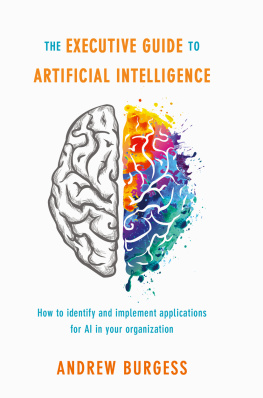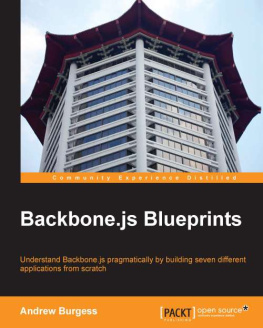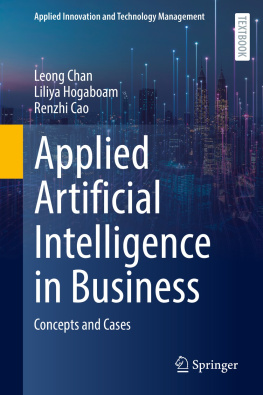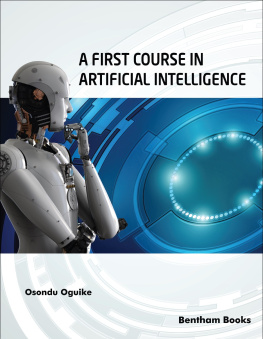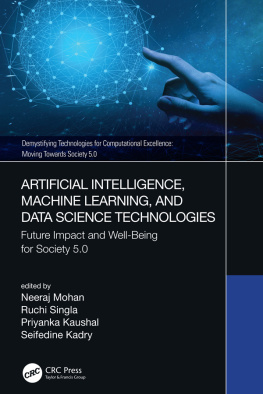Introduction
Read any current affairs newspaper, magazine or journal, and you are likely to find an article on artificial intelligence (AI), usually decrying the way the robots are taking over and how this mysterious technology is the biggest risk to humanity since the nuclear bomb was invented. Meanwhile the companies actually creating AI applications make grand claims for their technology, explaining how it will change peoples lives whilst obfuscating any real value in a mist of marketing hyperbole. And then there is the actual technology itselfa chimera of mathematics, data and computersthat appears to be a black art to anyone outside of the developer world. No wonder that business executives are confused about what AI can do for their business. What exactly is AI? What does it do? How will it bene fit my business? Where do I start? All of these are valid questions that have been, to date, unanswered, and which this book seeks to directly address.
Artificial Intelligence, in its broadest sense, will have a fundamental impact on the way that we do business. Of that there is no doubt. It will change the way that we make decisions, it will enable completely new business models to be created and it will allow us to do things that we never before thought possible. But it will also replace the work currently being done by many knowledge workers, and will disproportionally reward those who adopt AI early and effectively. It is both a huge opportunity and an ominous threat wrapped up in a bewildering bundle of algorithms and jargon.
But this technological revolution is not something that is going to happen in the future; this is not some theoretical exercise that will concern a few businesses. Artificial Intelligence is being used today in businesses to augment, improve and change the way that they work. Enlightened executives are already working out how AI can add value to their businesses, seeking to understand all the different types of AI and working out how to mitigate the risks that it inevitably brings. Many of those efforts are hidden or kept secret by their instigators, either because they dont want the use of AI in their products or services to be widely known, or because they dont want to give away the competitive advantage that it bestows. A persistent challenge for executives that want to get to grips with AI is where to find all the relevant information without resorting to fanciful articles, listening to vendor hyperbole or trying to understand algorithms . AI is firmly in the arena of conscious unknownswe know that we dont know enough.
People generally experience AI first as consumers. All our smartphones have access to sophisticated AI, whether that is Siri , Cortana or Googles Assistant. Our homes are now AI enabled throug h Amazons Alexa and Google Home. All of these supposedly make our lives easier to organise, and generally they do a pretty good job of it. But their use of AI is actually pretty limited. Most of them rely on the ability to turn your speech into words, and then those words into meaning. Once the intent has been established, the rest of the task is pretty standard automation ; find out the weather forecast, get train times, play a song. And, although the speech recognition and natural language understanding (NLU) c apabilities are very clever in what they achieve, AI is so much more than that, especially in the world of business.
Artificial Intelligence can read thousands of legal contracts in minutes and extract all the useful information out of them; it can identify cancerous tumours with greater accuracy than human radiologists; it can identify fraudulent credit card behaviour before it happens; it can drive cars without drivers; it can run data centres more efficiently than humans; it can predict when customers (and employees) are going to desert you and, most importantly, it can learn and evolve based on its own experiences.
But, until business executives understand what AI is, in simple-enough terms, and how it can help their business, it will never reach its full potential. Those with the foresight to use and exploit AI technologies are the ones that need to know what it can do, and understand what they need to do to get things going. That is the mission of this book. I will, over the course of the ten chapters, set out a framework to help the reader get to grips with the eight core capabilities of AI, and relate real business examples to each of these. I will provide approaches, methodologies and tools so that you can start your AI journey in the most efficient and effective way. I will also draw upon interviews and case studies from business leaders who are already implementing AI, from established AI vendors , and from academics whose work focuses on the practical application of AI.
Introducing the AI Framework
My AI Framework was developed over the past few years through a need to be able to make sense of the plethora of information, misinformation and marketing-speak that is written and talked about in AI. I am not a computer coder or an AI develope r, so I needed to put the world of AI into a language that business people like myself could understand. I was continually frustrated by the laziness in the use of quite specific terminology in articles that were actually meant to help explain AI, and which only made people more confused than they were before. Terms like Artificial Intelligence, Cognitive Automation and Machine Learnin g were being used interchangeably, despite them being quite different things.
Through my work as a management consultant creating automation strategies for businesses, through reading many papers on the subject and speaking to other practitioners and experts, I managed to boil all the available information down into eight core capabilities for AI: Im age Recognition, Speech Recognition , Search , Clustering , NL U, Optimisation , Prediction and Understanding . In theory, any AI application can be associated with one or more of these capabilities.
The first four of these are all to do with capturing information getting structured data out of unstructured, or big, data. These Capture categories are the most mature today. There are many examples of each of these in use today: we encounter Speech Recognition when we call up automated response lines; we ha ve Image Recognition automatically categorising our photographs; we have a Search capability read and categorise the emails we send complaining about our train being late and we are categorised into like-minded groups every time we buy something from an online retailer. AI efficiently captures all this unstructured and big data that we give it and turns it into something useful (or intrusive, depending on your point of view, but thats a topic to be discussed in more detail later in the book).
The second group of NLU, Optimisation and Prediction are all trying to work out, usually using that useful information that has just been captured, what is happening . They are slightly less mature but all still have applications in our daily lives. NLU turns that speech recognition data into something usefulthat is, what do all those individual words actually mean when they are put together in a sentence? The Optimisation capability (which includes problem solving and planning as core elements) covers a wide range of uses, including working out what the best route is between your home and work. And then the Prediction capability tries to work out what will happen nextif we bought that book on early Japanese cinema then we are likely to want to buy this other book on Akira Kurosawa.

